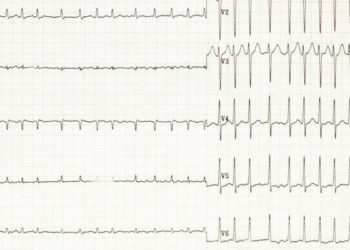Treatment of liver metastases in colorectal cancer with radiofrequency ablation (RFA) show efficacy in improving long-term survival
Image: PD
Key study points:
1. 93.1% of metastases were successfully treated, with no evidence of residual enhancing tumor, after first ablation treatment. The remaining 6.9% successfully retreated with early re-ablation.
2. Local tumor progression (LTP) occurred in 11.9% of metastases treated. Participants who received re-ablation for LTP demonstrated improved survival compared to those who did not.
3. Overall, 5- and 10-year survival rates for participants treated with RFA were 47.8% and 18.0%, respectively.
Primer: Colorectal cancer (CRC) is the third most common cancer in both men and women, but the second most common cause of cancer-related deaths, claiming over 50,000 lives a year. The high fatality of this malignancy resides in its affinity for metastasis, with the liver being the most common site. More than half of patients with CRC develop liver metastases and if left untreated, patients with hepatic metastases survive only a median of 10.6 months after diagnosis, with few-to-none surviving to 5 years followup. Surgical resection has long been the treatment of choice for liver CRC metastases, demonstrating success in improving 5-year survival to 24-38%. Unfortunately, only 25% of liver metastases achieve criteria for resection and much research effort in recent years has concentrated on developing treatments for the remaining 75% of CRC liver metastases that are not amenable to resection, either due to unfavorable tumor factors (size, multiplicity, and location) or problematic patient factors (age and comorbidities).
Combination chemotherapies have shown promise in the treatment of liver CRC metastases. A three-drug regimen of 5-fluorouracil, leucovorin, and oxaliplatin demonstrated a median 5-year survival of 28%, with 51% of the treated tumors later becoming amenable to resection. However, while these results are encouraging, chemotherapy efficacy remains low and adjuvant therapy using such toxic agents inevitably produces numerous unwanted side effects, thus spurring the search for a better intervention.
RFA utilizes an instrument to produce radio frequencies that induce high temperatures at a needle-like tip, which is applied directly to the tumor. This cytotoxic effect has proven to be high efficacious in the treatment of both primary and metastatic liver tumors, with a recurrence rate of <2% by 15 months followup and 5-year survival rates (24-44%) similar to that of surgical resection. However, while short-term results are promising, few studies have provided evidence of long-term efficacy. Thus, current guidelines have deferred definitive recommendations regarding the use of RFA until evidence of long-term outcomes become available. To address this unanswered question, the authors of this study conducted a retrospective analysis of longitudinal data to investigate the long-term efficacy of percutaneous RFA in the treatment of liver CRC metastases.
Background reading:
3. Radiofrequency Ablation of Unresectable Primary and Metastatic Hepatic Malignancies [Ann surg]
This [retrospective] study: 99 consecutive patients with 255 metachronous hepatic CRC metastases who treated using percutaneous hepatic RFA between 1997 and 2006 at the General Hospital of Busto Arsizio were studied. While all study participants received surgical resection of their primary CRC malignancy, their liver metastases were either deemed nonresectable or the patients refused surgical resection. Ablations were performed with ultrasound guidance and using commercially available RFA devices. Patients were also treated with adjuvant combination chemotherapy. Contrast enhanced imaging (CT or MRI) every 3-4 months for the first 3 years, and every 4-5 months thereafter was used to monitor for the success of initial treatment (defined as absence of contrast enhancement in the target site), local tumor progression (LTP, contrast enhancement in or adjacent to the treatment site) and new metastases (NM, contrast enhancement at a new site) as well as to assess for efficacy in repeat treatments of LTP and NM with RFA, if done.
Data analysis revealed several important findings:
- 93.1% of the metastases were successfully treated with 1 ablation. The remaining 6.9% of tumors with residual enhancement were re-ablated within 1 month, with successful treatment in 100% of these tumors.
- Median followup was 53 years. Overall 1-, 3-, 5-, 7-, and 10-year survival rates were 98.0%, 69.3%, 47.8%, 25.0%, and 18.0%, respectively.
- 32.3% of patients had LTP at the RFA treatment site, with the majority receiving re-ablation. Those re-treated with RFA demonstrated longer median survival (45.5 months) compared to those who were not re-ablated (31.0 months, p<0.001).
- 24.7% of participants developed NM within 5 years of followup, with 50% of NMs identified within 5 months of treatment and 90% identified within 20 months of treatment.
- There was no difference in the incidence of LTP or NM or in the 10-year survival between participants with one, two, three, or four or more metastasis (p=0.724) or in relation to tumor size (p=0.08).
In sum: This study is the longest study to date demonstrating long-term efficacy for RFA in the treatment of hepatic metastases in CRC, with 5- and 10-year survival rates similar to that of surgical resection. The findings that NM are common and that LTP could be effectively retreated with radioablation further supports the utility of this high-repeatable, minimally invasive technique in both the initial treatment and continuous followup of nonresectable hepatic metastases.
However, this study does face several important limitations. First, the small number of participants and the single-center location of the study reduces its generalizability to population wide clinical practice. Second, because participants were treated with both RFA and chemotherapy, it is difficult to distinguish whether improved outcomes are due to adjuvant chemotherapy, RFA or the combination of both. Finally, because this study is retrospective in design, there was little that could be done to control for bias or prevent crossover, which may have affected the outcomes measured.
Click to read the study in [Radiology]
By [MK]
© 2012 2minutemedicine.com. All rights reserved. No works may be reproduced without written consent from 2minutemedicine.com. DISCLAIMER: Posts are not medical advice and are not intended as such. Please see a healthcare professional if you seek medical advice.





